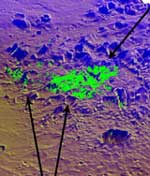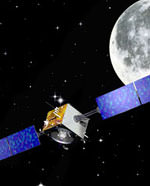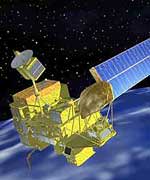
Image credit: NASA
Astronomers have uncovered a green mineral on Mars called olivine that could indicate that the planet has been completely dry for at least a billion years, since the mineral was exposed to the Martian air. Olivine is found in many rocks on Earth, and it’s highly susceptible to chemical weathering. If liquid water was present at any time in the past, the olivine would have altered into other materials – but this hasn’t happened. The areas will be further investigated in 2005 by the upcoming Mars Reconnaissance Orbiter, which has 100 times the resolution of the Mars Global Surveyor.
The presence of a common green mineral on Mars suggests that the Red Planet could have been cold and dry since the mineral has been exposed, which may have been more than a billion years ago, according to new research appearing in the Oct. 24 edition of Science.
Todd Hoefen, a Denver-based U.S. Geological Survey (USGS) geophysicist, led a team of researchers from USGS, Arizona State University and NASA, that found abundant quantities of olivine on Mars at least locally. They based their conclusions on data obtained from a Thermal Emission Spectrometer (TES) carried by NASA’s Mars Global Surveyor (MGS) spacecraft.
Olivine, a transparent, green-colored mineral found in many rocks containing magnesium and iron (mafic igneous rocks), is highly susceptible to chemical weathering and readily alters to other minerals in the presence of liquid water (minerals such as iddingsite, goethite, serpentine, chlorite, smectite, maghemite and hematite). Except for trace amounts of hematite, which gives Mars its red color, none of these other weathering products have been detected at kilometer scales on Mars.
The team detected a 30,000 square kilometer (18,720 square mile) area rich in olivine, in the Nili Fossae region of Mars, which makes up ~ 0.02 % of the planet by area. Nili Fossae has been interpreted as a complex of grabens (long depressions between geologic faults) and fractures related to the formation of the Isidis impact basin, where post-impact faulting most plausibly exposed the locally abundant olivine. They have also found smaller deposits of olivine all over the planet, all indicating a surface at least regionally dominated by volcanic processes.
The fact that so much olivine is exposed at the surface in the Nili Fossae region indicates that there has been little to no weathering due to water, thus no liquid water-mineral chemical reactions. The absolute age of the surface is somewhat uncertain but is probably over 3 billion years old, on the basis of our best current estimates. If, however, such surfaces have been more recently exposed, one would not expect for the olivine to have been chemically altered due to the current environmental conditions on Mars (cold, dry).
It took approximately three years for the MGS spacecraft and the TES instrument to gather the data for the analysis, and another year for scientists to analyze and fully interpret the results. The MGS spacecraft is healthy and continues to map Mars.
“The detection of minerals such as olivine that serve as fingerprints of the geological processes responsible for forming the Martian surface we are exploring today is a vital part of the overall Mars Exploration Program science strategy,” stated Dr. Jim Garvin, NASA’s Lead Scientist for Mars at NASA Headquarters. “The provocative findings by Hoefen and his team will be further investigated when NASA’s 2005 Mars Reconnaissance Orbiter turns its hyperspectral imaging spectrometer, with 100 times the spatial resolution of the MGS TES instrument, on these olivine-rich regions in a few years,” continues Garvin.
The USGS serves the nation by providing reliable scientific information to describe and understand the Earth; minimize loss of life and property from natural disasters; manage water, biological, energy, and mineral resources; and enhance and protect our quality of life.
Original Source: NASA News Release






